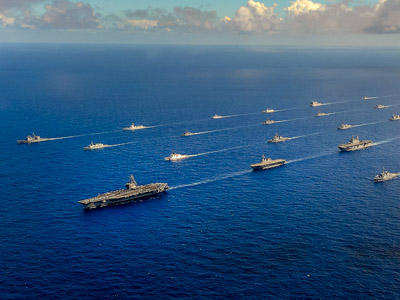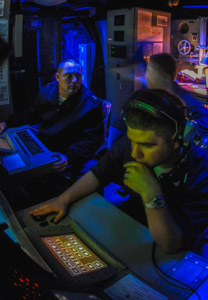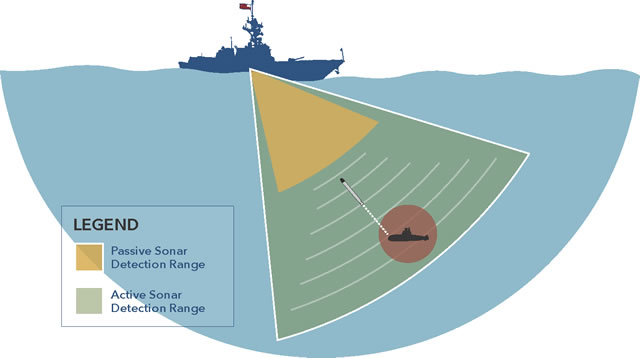The Naval Services' Proposed Action is to conduct military readiness activities within the Hawaii-California Training and Testing Study Area. These activities include the use of active sonar and explosives while employing marine species protective mitigation measures. These proposed activities are generally consistent with those analyzed in the Hawaii-Southern California (HSTT) EIS/OEIS completed in December 2018 and other environmental planning documents, which are representative of military readiness activities that the Naval Services have been conducting off Hawaii and California for decades.
The Navy and Marine Corps’ purpose for the Proposed Action is to ensure that the Department of the Navy meets its statutory mission, which is to maintain, train, and equip combat-ready naval forces capable of winning wars, deterring aggression, and maintaining freedom of the seas. This mission is achieved in part by conducting training and testing within the Study Area in accordance with established Naval military readiness requirements.
The U.S. Coast Guard’s purpose for the Proposed Action is to ensure Coast Guard personnel can qualify and train jointly with, and independently of, the Navy and other services in the effective and safe operational use of Coast Guard vessels, aircraft, and weapons under realistic conditions. These activities help to ensure that the Coast Guard can safely protect our Nation's Naval safety, security, and natural resources as per their national defense mission authority.
To achieve and maintain military readiness, the Naval Services propose to:
- Conduct training and testing activities at levels required to support military readiness requirements beginning in 2025; and
- Accommodate evolving mission requirements, including those resulting from the development, testing, and introduction of new vessels, aircraft, and weapons systems into the fleet.
The type and level of activities included in the Proposed Action account for fluctuations in training and testing to be able to meet evolving or emergent requirements.
Military service members must be ready to respond to many different situations when called upon. The skills needed to achieve readiness are challenging to master and require constant practice. Training must be diverse and as realistic as possible to fully prepare service members for what they will experience in real-world situations and to ensure their success and survival.
Equipment and systems must be tested before use during deployment. Systems are tested in varying marine environments, such as differing water depths, seafloor types, salinity levels, and other ocean conditions, as well as replicated warfighting environments, to ensure accuracy and safety.
While simulators provide early skill repetition at the basic operator level and enhance teamwork, there is no substitute for live training and testing in a real-world environment.

|
Defense against enemy submarines is a top priority for the Naval Services. To detect and counter potential hostile submarines, the Naval Services use both passive and active sonar. Torpedoes, in-water mines, and quieter submarines are true threats to global commerce, national security, and the safety of service members operating in the marine environment. Active sonar is the most effective method of detecting these threats.
Sonar proficiency is a complex and perishable skill that requires regular, hands-on training in realistic and diverse conditions, such as those provided in the Hawaii California Training and Testing Study Area. Lack of realistic training will jeopardize the lives of service members in real-life combat situations.
|
 |
 |
| Submarines of the previous generation were noisy and could be detected with passive sonar before they came close enough to deploy short-range weapons against a vessel. Extremely quiet, difficult-to-detect, diesel-electric submarines can approach close enough to deploy long-range weapons before entering the passive sonar detection range of U.S. vessels. Active sonar has a longer detection range that is needed to allow Sailors to detect, identify, and track quieter, modern submarines before they are close enough to attack. |
Training in a high-stress environment, including the use of and exposure to explosive ordnance, is necessary for service members to be fully prepared to respond to emergencies and national security threats, and to ensure their safety.
Testing with explosive ordnance is essential for ensuring systems function properly in the type of environment they will be used. To the extent possible, service members train and conduct tests using inert (non-explosive) practice munitions. Non-explosives, however, cannot completely replace training and testing in a live environment. Limited training and testing with in-water explosives occurs only in established operating areas, and the Naval Services issue notices to mariners and pilots to ensure public safety.
Using the most current and best available science and analytical methods, the Naval Services evaluated the potential environmental impacts associated with three alternatives:
No Action Alternative: No authorizations or permits would be issued by the National Marine Fisheries Service, and the Navy would not conduct the proposed training and testing activities in the Hawaii California Training and Testing Study Area.
Alternative 1 (Preferred Alternative): The Naval Services would conduct military readiness training and testing activities, as necessary to meet current and future readiness requirements. The type and level of activities in Alternative 1 reflects a representative year to account for the natural fluctuation of training cycles and deployment schedules that generally limit the maximum level of training from occurring year after year in any seven-year period.
Alternative 2: This alternative includes new and ongoing training and testing activities to enable the Naval Services to meet the highest levels of required military readiness. Alternative 2 reflects the maximum number of training and testing activities that could occur within a given year and assumes that the maximum level of activity would occur every year over any seven-year period. Alternative 2 would allow for the greatest flexibility for the Naval Services to maintain readiness when considering potential changes in the national security environment, fluctuations in schedules, and anticipated demands.
The environmental review process includes:
- Phase I: The Navy completed three environmental documents between 2008 and 2012, which included:
- Hawaii Range Complex EIS/OEIS (2008)
- Southern California Range Complex EIS/OEIS (2008)
- Silver Strand Training Complex EIS (2012)
- Phase II: The Navy consolidated these three Phase I environmental planning documents into the Hawaii-Southern California Training and Testing EIS/OEIS, completed with public input in 2013. In the Phase II Hawaii-Southern California Training and Testing EIS/OEIS, the Navy re-evaluated impacts from ongoing training and testing activities and updated training and testing activities, occurring in the Hawaii-Southern California Training and Testing EIS/OEIS Study Area from 2013 to 2018, based on changing requirements.
- Phase III: The Navy analyzed both ongoing and newly proposed training and testing activities in the Hawaii-Southern California Training and Testing EIS/OEIS Study Area from 2018 to 2025.
- Phase IV (Current Phase): The Navy is including U.S. Marine Corps and U.S. Coast Guard activities in an expanded Study Area (Hawaii-California Training and Testing Study Area) that now includes most of the offshore area of California, as far north as San Francisco. These Naval Services will re-evaluate impacts from military readiness activities starting in 2025 that are similar to activities evaluated in previous phases and include new activities.
Training and testing activities to be considered in the Hawaii-California Training and Testing (HCTT) EIS/OEIS are generally consistent with those activities analyzed in the 2018 Final Hawaii-Southern California (HSTT) EIS/OEIS and earlier environmental planning documents. Below are some of the anticipated differences between the two studies.
In the current action:
- The California portion of the Study Area will be expanded to include:
- a larger Southern California Range Complex, now with the West and South Extensions
- the Point Mugu Sea Range
- the Northern California Range Complex
- The Navy will revise the range boundaries of the Shallow Water Tracking Range (SWTR) in the Southern California Range Complex
- The Navy will install an oceanic fiber-optic communications cable linking San Clemente Island, Camp Pendleton, and Point Mugu Sea Range
- U.S. Marine Corps and U.S. Coast Guard training activities will be included with U.S. Navy training activities.
- Includes analyses of increases in testing of some new vessels, aircraft, weapons systems, and unmanned vehicles, and decreases in other testing activities
- Includes improved acoustic models, updated marine mammal and sea turtle densities, and updated marine species criteria and thresholds
- Continues to use the most current and best available science and analytical methods
- Reviews procedural mitigations, where appropriate, and considers additional geographic and/or temporal mitigations, where applicable